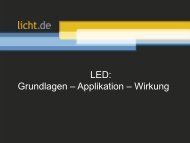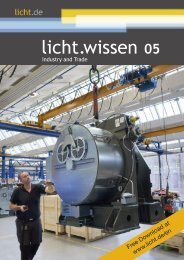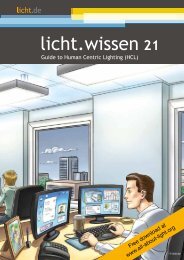licht.wissen No. 09 “Refurbishment in Trade, Commerce and Administration“
An extensive survey of offices, workshops and school classrooms shows that lots of lighting installations are obsolete. licht.wissen 09 informs that refurbishment sustainably lowers energy consumption, saves costs and makes for a significant improvement in lighting quality. This booklet from licht.de contains impartial advice for consultations with commercial clients. It also flags up web tools for assessing lighting installations and making design recommendations. Free Download at www.licht.de/en
An extensive survey of offices, workshops and school classrooms shows that lots of lighting installations are obsolete. licht.wissen 09 informs that refurbishment sustainably lowers energy consumption, saves costs and
makes for a significant improvement in lighting quality.
This booklet from licht.de contains impartial advice for consultations with commercial clients. It also flags up web tools for assessing lighting installations and making design recommendations. Free Download at www.licht.de/en
Create successful ePaper yourself
Turn your PDF publications into a flip-book with our unique Google optimized e-Paper software.
licht.wissen 09
Refurbishment in Trade, Commerce and Administration
Lighting solutions for optimal efficiency
Low energy consumption is one of a lighting installation’s quality features. Efficient lighting technology
and intelligent utilisation of daylight are good for the environment, lower operating costs and help make for
business success.
Climate change and scarce resources are
forcing us to re-think the way we live. And
action is being taken at political level: targets
and the line of approach are set out in
the German Energy Saving Ordinance
(EnEV) and the EU Ecodesign Directive for
energy-related products, which is transposed
into German law as the Energy-
Using Products Act (EBPG).
Another force for change is the relentless
rise of energy prices. Inefficient products
are thus gradually disappearing from the
market.
EnEV 2014:
Even more efficient buildings
Low and ultra-low energy buildings will
soon be the norm. In 2009, the EU tightened
up the building directive approved in
2007; the next stage followed in 2014.
Member states are now required to transpose
the latest update into national law. In
Germany, that step was taken in May 2014,
when a new Energy Saving Ordinance
(EnEV) came into force.
From now on, the overall energy performance
of buildings needs to meet even more
exacting standards. And energy certificates
are required for more than just non-residential
buildings with a floor area in excess of
1,000 square metres. The size threshold is
lowered to 500 square metres and buildings
with a high volume of public traffic are
included. Hotels, cinemas and small company
premises thus also require an energy
certificate. So lighting is under scrutiny.
EnEV requires the owner of a building to
establish the building’s total energy consumption:
before a building is refurbished
or constructed, the primary energy demand
for lighting needs to be calculated in accor-
[08] The refurbishment of an old lighting installation
makes for significantly more lighting
comfort and saves a great deal of energy.
The greatest efficiency is guaranteed by lighting
management systems with presence
control and daylight regulation.
[09] Daylight-dependent lighting control
saves energy: the artificial lighting is automatically
switched and dimmed as required.
Sensors at windows and in the room ascertain
the current lighting level and send signals
to regulate the artificial lighting as required.
[10] Different lighting scenes can be easily
accessed from a display panel.
[11] Energy-saving room lighting: Sensors
measure the available daylight and regulate
the light required in the room. Because the
room in this example is sufficiently flooded
with daylight, the luminaires at the window
are deactivated and those in the middle of
the room dimmed. Only the luminaires in the
deeper part of the room are operating at full
capacity.
08
Savings potenzial of interior lighting
0% 50% Energy consumption 100%
Old installation, 1970s, with 38 mm dia. standard fluorescent lamp and MB,
old luminaire with opal enclosure
Old installation, 1980s, with 26 mm dia. three-band fluorescent
lamp and LLB, old luminaire with white louver unit
New installation, modern
16 mm dia. fluorescent lamp*
Modern LED luminaire
With daylight
regulation
With presence
control+daylight
regulation
75%
80%
65%
55%
100% energy saving 50% 0%
* Fluorescent lamp operated by EB with very low power loss, energy-efficient
direct or direct/indirect luminaires with modern optical control technology
20%
© © licht.de
10
















